
Imagine what your mouth would feel like if you never brushed your teeth or went to the dentist. For many dogs and cats, this is a painful reality. According to the American Veterinary Dental Society, more than 80% of dogs and 70% of cats have dental disease by the age of 3. Dental (or periodontal) disease is the most frequently diagnosed health problem in pets.
Common signs of dental disease include:
- Yellow or brown buildup (tartar) on the teeth
- Red, swollen, or bleeding gums
- Bad breath
- Excessive drooling
- Changes in eating or chewing habits
- Pawing at the face
- Loose teeth
- Depression
Even if your dog or cat doesn’t have these symptoms, we recommend that you have a veterinarian evaluate your pet’s dental health at least once a year. Bacteria and food debris accumulate around the teeth and, if left unchecked, will lead to deterioration of the soft tissue and bone surrounding the teeth. This decay can result in irreversible periodontal disease, tooth loss, and possibly expensive oral surgery.
Dental disease is not just limited to the mouth; it can also affect other organs in the body. Bacteria in the mouth can get into the bloodstream and cause serious infections in the kidneys, liver, lungs, and heart. A physical exam combined with appropriate laboratory work can determine if infection in the mouth has spread.
Schedule your pet’s dental exam today! We can also show you how to brush your pet’s teeth and recommend foods and treats that will help combat plaque and tartar buildup, so give us a call today to schedule an oral exam!
Our dental procedures are split into two stages which are explained below:
Stage 1 – The Cleaning, includes:
- a complete assessment of your pet’s oral health including their teeth, gums, and other structures in the oral cavity
- full mouth dental radiographs
- ultrasonic scaling (plaque and calculus removal) and polishing of all teeth
- warm laser treatment of the gums to reduce inflammation
- at the doctor’s discretion, minor extractions of single-rooted loose teeth that do not require oral surgery may be done during Stage 1 also
*Not all pets will need a Stage 2. If further extractions are needed, a Stage 2 Dental will be scheduled during discharge of the initial dental.
Stage 2 – Surgery, occurs at least 2-3 weeks after Stage 1, and includes:
- surgical extraction of diseased teeth or other oral surgical procedures
- post operative dental x-rays
- post operative warm laser treatment of all extraction sites to reduce inflammation and speed healing
- intraoperative and postoperative pain management
Pet parents will not be charged twice for anesthesia. The only cost associated with Stage 2 will be for the extractions and medications to go home.
There are many benefits to this system. The most significant are:
- Reduction of anesthesia time. While anesthetic emergencies can occur at any time, they are more likely to occur during prolonged anesthetic procedures. Extractions and oral surgery can add hours of anesthesia time to the initial cleaning. Reducing time under general anesthesia per procedure reduces risk for the patient, especially those with other health conditions that put them at a higher risk of anesthetic complications. Anesthetic-related side effects such as low blood pressure, prolonged recovery time and low body temperature are also reduced.
- Decreased bacterial contamination during oral surgeries. By first removing plaque and calculus, there is less chance of bacteria causing complications in extraction sites.
- Healthy tissues are more reliably closed. Gum tissue that has had time to heal and “calm down” once infection is controlled is much healthier and allows extraction sites to be closed more easily and with fewer complications than tissue that is irritated and diseased. For some patients, antibiotics may be prescribed in the interval to provide additional medical support.
- Advanced planning. Once initial radiographs have been obtained and diseased teeth identified, the doctor has time to plan for the best surgical approach. Often large, multi-rooted teeth require gum flaps, removal of bone, and sutures to close the extraction site(s). Having the ability to make a plan in advance will help us reduce procedure time and provide the best outcome to the patient.
- Easier financial planning. Once we evaluate the dental radiographs in Stage 1 we will know exactly how many/which teeth need to be extracted so that a precise estimate can be provided for the second procedure when required. This also allows the pet parent to plan for the expense of the extractions over the interim 2-3 weeks, rather than having to scramble when unexpected extractions result in a higher-than-anticipated bill on the day of the dental.
- More efficient scheduling of surgical procedures. By being better able to estimate the time a dental procedure will require, we will be able to adjust our surgery schedule to accommodate more procedures, allowing us to get patients scheduled in a more timely manner.


